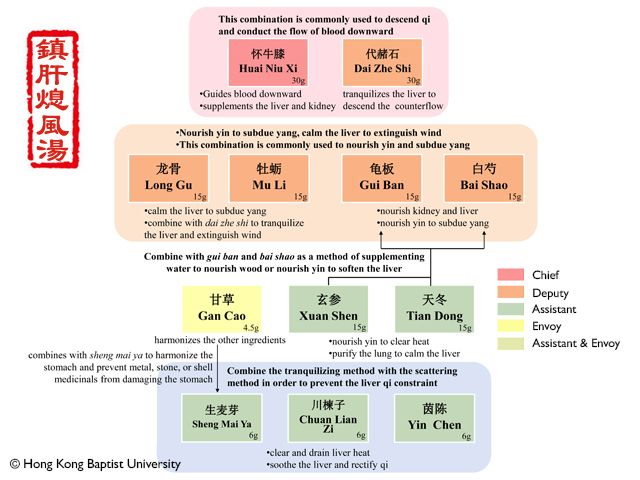NameLiver-Sedating and Wind-Extinguishing Decoction
ClassificationWind-calming formulas
CombinationAchyranthis Bidentatae Radix (Huai Niu Xi) 1 liang (30g), Haematitum (Sheng Zhe Shi) 1 liang (30g), Draconis Os (Sheng Long Gu) 0.5 liang (15g), Ostreae Concha (Sheng Mu Li) 0.5 liang (15g), Testudinis Plastrum (Sheng Gui Ban) 0.5 liang (15g), Paeoniae Radix Alba (Sheng Hao Shao) 0.5 liang (15g), Scrophulariae Radix (Xuan Shen) 0.5 liang (15g), Asparagi Radix (Tian Dong) 0.5 liang (15g), Toosendan Fructus (Chuan Lian Zi) 0.2 liang (6g), Hordei Fructus Germinatus (Sheng Mai Ya) 0.2 liang (6g), Artemisiae Scopariae Herba (Yin Chen) 0.2 liang (6g), Glycyrrhizae Radix et Rhizoma (Gan Cao) 1.5 qian (4.5g)
MethodPrepare the ingredients as a decoction.
ActionTranquilizes the liver and extinguishes wind, enriches yin and subdues yang.
IndicationZhen Gan Xi Feng Tang is indicated for the pattern of apoplectic stroke. The symptoms are dizziness, vertigo, distension of eyes, tinnitus, headache with a warm sensation in the head, flushed face, and irritability; there may also be frequent belching, progressive difficulty in moving the extremities, and deviation of the mouth and eyes. In severe cases there is dizziness and falling down, unconsciousness, mental confusion with moments of clarity, and an inability to fully recover after loss of consciousness, and a wiry, long, and forceful pulse.
PathogenesisThis is a pattern of wind-like strike caused by liver and kidney yin deficiency, hyperactivity of liver yang, internal stirring of liver wind, and upward reversal of qi and blood. There is vertigo, swollen eyes, and tinnitus because liver yang transforms into wind, which harasses upward when there is liver and kidney yin deficiency and hyperactivity of liver yang. The blood counterflows upwards with the counterflow qi that is ascending due to the wind, so there is a hot and painful sensation in the brain, a drunk-like flush, and possibly a stroke due to the counterflow of qi and blood. A mild case is caused by wind attacking the channels and collaterals, which results in gradual loss of body mobility and a gradual deviation of the mouth. A severe case is caused by wind attacking the zang-fu organs, which results in sudden vertigo, fainting, and unconsciousness. A wiry, long, and powerful pulse is the sign of excessive liver yang. This syndrome has its root in liver and kidney yin deficiency and its branch in the hyperactivity of liver yang and the ascending counterflow of qi and blood. However, the excessive branch overwhelms the deficient root. It should be treated by tranquilizing the liver, extinguishing wind, and subduing blood as the main method, and assisted by nourishing the liver and kidney.
ClarificationWhy are medicinals that soothe the liver and regulate qi included in a formula used to treat hyperactivity of liver yang and upward harassing of wind?
Application1. Essential pattern differentiation Zhen Gan Xi Feng Tang serves as the common formula used to treat wind-like strike whether it is a pre-strike, strike, or post-strike. This clinical pattern is marked by vertigo, hot and painful sensation in the brain, drunk-like flush, wiry, long, and powerful pulse. 2. Modern applications This formula may be used in the following biomedically defined disorders when the patient shows signs of liver-kidney yin deficiency and ascendant hyperactivity of liver yang: hypertension, cerebral thrombosis, cerebral hemorrhage, and angioneurotic headache. 3. Cautions and contraindications It is not applicable for stroke due to qi deficiency and blood stasis.
Additonal formulaeJian Ling Tang (Down Sweeping Decoction 建瓴汤)
RemarkReeves' Terrapin ( Chinemys reevesii / Mauremys reevesii ) is listed as "Endangered" in the International Union for the Conservation of Nature and Natural Resources (IUCN) Red List of Threatened Species. Also, it is listed in the Convention on International Trade in Endangered Species of Wild Fauna and Flora (CITES) Appendix III. Its trade is regional control and subject to permits or certificates of origin.
Source《Records of Chinese Medicine with Reference to Western Medicine》Yi Xue Zhong Zhong Can Xi Lu《醫學衷中參西錄》
